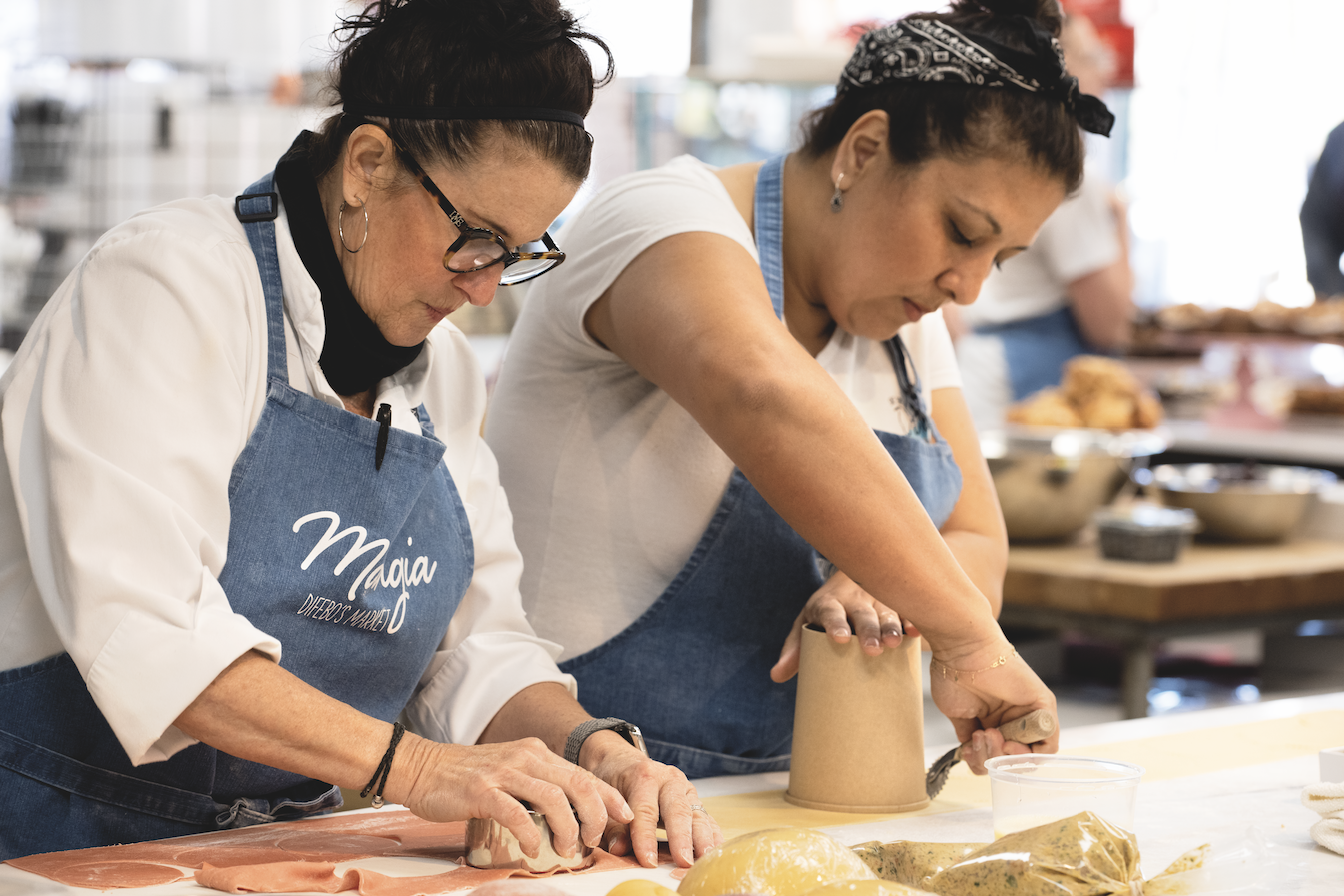
Coming up with the right combo takes time and a willingness to test new ideas
By Pam George
Photograph by Scott Nathan
From the May 2022 issue

As a young chef, Lisa DiFebo-Osias worked in Florida and New York establishments, executing the same dishes each night. The then-20-year-old quickly grew bored, and she vowed that no one working under her would feel that way.
Today, the owner of two coastal DiFebo’s restaurants revamps her menu every three months. “And sometimes, depending on my travels, I might change it every week to reflect where I’ve been that week or that month,” says DiFebo-Osias, who has locations in Bethany Beach and downtown Rehoboth.
Menu planning, however, is far from easy. Indeed, DiFebo-Osias and her husband, Jeff Osias, have spent plenty of road trips hotly debating a new dish’s merits or the validity of an ingredient. The brainstorming part is only the beginning. Chefs must also consider the concept, sales, seasonality, sustainability and price.
In a competitive market like this one, the right blend is crucial.
Begin with the basics
The concept makes a difference. DiFebo-Osias’s restaurants pull from her roots; both sides of her family emigrated from Italy. A seafood restaurant, such as Big Fish Grill, or a Mexican spot, such as Agave or Taco Reho, also need to provide the expected offerings.
In Rehoboth Beach, Chesapeake & Maine celebrates the cuisines of both locales. Lobster is flown in from Maine, and oysters come from both areas.
But the concept isn’t always focused on a cuisine. C&M’s sister restaurant is Dogfish Head Brewings & Eats, a brewpub. It’s up to the chef to create a cohesive menu that supports the vibe. Zach Dick, who oversees both restaurants, uses food to support the company’s mission, which includes protecting the environment, supporting local businesses, and providing artisan products. To that end, the restaurant uses ground beef from Roseda Farm near Baltimore, which dry-ages all its beef, and the kitchen makes the brioche buns for the burgers. “The server must be able to tell the story about why we use it, and why a purveyors’ mission or values are aligned with ours,” Dick says.
Thompson Island Brewing Company near Rehoboth is also a brewpub. In the kitchen, a wood-fired oven unites such seemingly disparate dishes as meatloaf, Thai salmon, New York strip steak and slow-cooked pork ribs — flame-cooked food that complements the brewpub’s beers. The restaurant has also become known for its fried chicken.
The menu is primarily the creation of Doug Ruley, vice president of culinary operations for SoDel Concepts, which owns Thompson Island and 15 other coastal restaurants. Although the newest project in the hospitality group, Ocean View Brewing Company, is also a brewpub, Ruley created a fresh menu. Thompson Island sports a theme that embraces the area’s hunting and fishing history, but the southern location has a “coastal farmhouse/beach house feel,” Ruley says. Ocean View’s menu reflects the differences, with street corn nachos, fried green tomato sandwiches, duck leg confit, beer-battered jumbo shrimp, and a fun take on the classic TV dinner.
However, both brewpubs feature fried chicken, a hummus platter and soft pretzels. Indeed, SoDel Concepts has so many restaurants that some crossover is inevitable. For instance, shrimp-and-grits and deviled eggs are trending at most coastal eateries, and several SoDel Concepts restaurants offer them. To keep things fresh, each chef puts his or her spin on the dishes.
Switch it up
To anchor a theme, every restaurant needs consistent staples, many of which become crowd favorites. At least 10 old-school specialties have been on DiFebo’s menu since opening in 1989.
But few restaurants stay totally static. Ruley tweaks SoDel Concepts’ menus up to four times a year — “but it’s not out of the question to change and reprint when we see fit,” he says.
What gets the ax? Each week, SoDel chefs run a menu-engineering exercise to review sales, profit and the popularity of the individual dishes. “It gives us a good measure of whether a menu item is working for us,” Ruley says. “Or if maybe it’s time to rethink that specific item.” If a chef wants to nix an item, Ruley requests research to justify the change. “Is the dish not selling? Did the cost of the item go up? Does it just need a break?” he asks.
A recipe may only need refinement, says Kathleen Hy, culinary director for Big Fish Restaurant Group. “Sometimes, I find a different way of executing a dish or perfecting it.”
DiFebo-Osias reviews daily sales reports. “There’s always going to be a bottom-dweller — one that doesn’t sell,” she says. Despite the figures, she keeps the items that underscore her brand. For instance, few diners want smelts, but they’re always available. “If two old Italian men come and want a basket of smelts with lemon and some salt, I’m good,” she quips.
At the beach, the seasons are precursors to change. “It plays to the chef’s advantage to use what is in season and local,” Ruley notes. Living in coastal Sussex gives chefs easy access to farmers, and many area growers use hoop houses or greenhouses to extend the seasons so Ruley can source many products year-round.
His first seasonal menu change occurs in spring, when fresh peas and asparagus are in their prime. Granted, some produce is short-lived. Take ramps, for instance. Hy wouldn’t put the wild onions on her spring menu, but she would incorporate them into specials.
Independently owned 50-seat restaurants such as One Coastal, which touts farm-to-table fare, are more flexible. Owner Matt Kern, who recently purchased the Fenwick restaurant from Carlie and Scott Carey, is passionate about touting local goods, and his menu changes frequently to reflect what’s available.
Waste not, want not
Kern also is dedicated to preventing food waste, a goal that is prevalent across the industry in one form or another. Hy asserts that “repurposing should come naturally to a chef; it is a deep part of many kitchen cultures.”
Bruised fruit becomes jam or jelly. Carrot greens are turned into pesto, and corn cobs and parmesan rinds are used for broth. At Salt Air, Hy uses vegetable scraps and chicken bone for stock. Along the same lines, an ingredient should have multiple applications, and the menu takes all of this into account.
Reducing kitchen waste saves money too, and cost control is an important part of menu planning. Bulk buying offers an economy of scale, which is why vegetables of the day accompany different entrees.
Hospitality groups possess another kind of buying power: They can negotiate lower prices for large orders. However, bulk orders might not work if company restaurants have small kitchens and no storage space. To solve that issue, Big Fish Restaurant Group created a commissary, which also handles the production of certain foods, such as crab cakes. “The commissary is consistent and efficient,” Hy says. “Only two people make the crab cakes, so we get the same product every time.”
Granted, it’s hard for any restaurant to avoid price increases, as the current inflation spike has demonstrated. “Everything has gone up 10 percent and as high as 100 percent,” Ruley notes. “Last summer, we were purchasing fresh jumbo crabmeat for almost three times the price as 2019.”
To offset ingredient and labor cost increases, menu prices are rising. Nationally, some restaurants are implementing COVID relief surcharges of between 5 and 10 percent. Beach restaurants, however, have an advantage: Buying from local fishermen and farmers reduces the cost of transporting goods, Ruley says.
Kern would agree. “I always ask the farmers: ‘What do you have that you can’t take to market?’” he says. “I’ll happily take beat-up peaches to keep them out of a landfill because I can cook them and make something delicious.”
Finding inspiration
To get ideas, Kern asks growers for new ingredients, such as lamb’s quarter, a fast-growing weed that’s also a tender, edible green. “I do 30 to 50 things to them and narrow them down to the best five, then the best two or three,” he says.
Hy looks to her own past and life experiences for ideas, while DiFebo-Osias uses travel as her muse. Italy was a goldmine for ideas, she says, and during a recent trip to Boston’s North End — which is peppered with small Italian restaurants — the Italian American chef and her husband ate numerous bowls of tortellini. “I came back thinking of how I could pull off tortellini,” she says.
Ruley is inspired by social media, cookbooks, conversations with other chefs and “taking something from years past and making it relevant again,” he notes. For instance, for the Ocean View menu, the team put a spin on Cracker Jack, the popcorn treat.
“We added Goldfish crackers and coconut milk,” explains Ruley, who has put the mix in the appetizer section. “Also, street corn is very popular and for good reason: it’s delicious. Our house nachos will have a street corn vibe with a corn pico, lime cream and jack cheese.” The finishing touch? Cheetos.
Dick encourages his chefs to get creative. “Let’s have fun with this,” he says. “Let’s try some things out.” Chesapeake & Maine recently debuted huevos rancheros with lobster, a sweet potato hash and refried beans. “The first special sold really well, and we put it on the menu.”
Indeed, taste tests are a critical part of the process. DiFebo-Osias now has DiFebo’s Market, which can serve as a test kitchen. Hy first runs a new dish as a special. To accurately describe the item, the staff must try it, which gives them the chance to offer feedback. Guests also provide input, and between those two sources, the chef can make changes — or “never run that dish again,” Ruley jokes.
For Ocean View Brewing Company, he hosted a special dinner at Thompson Island to give guests a peek at what they could expect at the new brewpub. “It
gave me the opportunity to fine-tune some things and also see if they were at all feasible,” Ruley explains. “Some dishes made the cut, and some did not.”
Duck meatballs went over well, but they took too long to make. If the restaurant’s opening team can’t have a dish ready to deliver to the guest in 10 minutes, it has no business being on the menu, he adds.
Speed is essential considering that SoDel Concepts’ tag line is “beautiful, simple food.” Nothing should be overly fussy or complicated. Sliced heirloom tomatoes with sea salt, high-quality olive oil and cracked pepper is a bestseller. “There is nothing better, and it’s quick,” Ruley says.
But when it comes to menu planning, even a simple salad requires hours of forethought.



